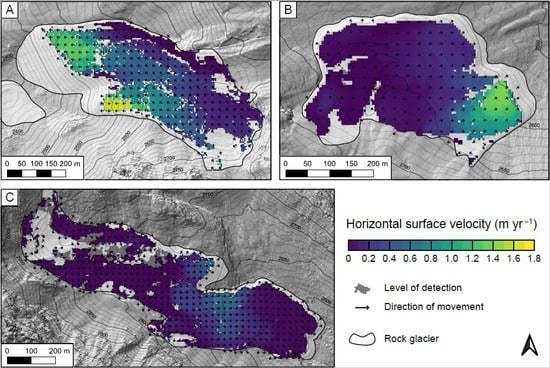Rock Glacier Kinematics in the Kaunertal, Ötztal Alps, Austria
Abstract
:1. Introduction
2. Study Area
3. Materials and Methods
3.1. Rock Glacier Inventory
3.2. Determining Horizontal Surface Movement Using Least Squares Matching
3.3. Statistical Analysis of Kinematics-Morphometry Relations
| Group | Parameter | Abbreviation | Unit | Source | Association | References |
|---|---|---|---|---|---|---|
| Geometry | Length 1 * † | LRG | m | RGI | Age | [62] |
| Width 1 * † | WRG | m | RGI | Thickening/thinning | [63] | |
| Surface Area 2 * | ARG | km2 | DEM RGI | Yield stresses | ||
| Height * † | HRG | m | DEM | |||
| Riser height 1 * † | HF | m | DEM | Thickness | [64,65] | |
| Morphology | Surface slope * † | ΦRG | ° | DEM | Shear stress PISR Snow distribution | [64] |
| Profile curvature * † Plan curvature * † | − | Compression/extension Subsidence Runoff characteristics | [3,22,66] | |||
| Surface roughness 3 | − | Grain size distribution | [65,67] | |||
| Terrain | Max. elevation Min. elevation * † | Emin Emax | m a.s.l. | DEM | MAAT Permafrost distribution Potential energy | [68,69,70] |
| N-exposedness 4 E-exposedness 4 * | − | Radiation Age Snow distribution | [71,72] | |||
| Mean PISR * † | kWh m−2 yr-1 | MAGST | [69,70,73] | |||
| Feeder basin | Height * | HFB | m | DEM 5 | Liquid water supply Snow & avalanche input | [62] |
| Area 2 * | AFB | km2 | ||||
| Slope * | ΦFB | ° | Runoff characteristics Liquid water supply | |||
| Geometric slope * | ΦGSL | ° | DEM | |||
| Headwall | Height | HHW | m | DEM 5 | Debris supply | [62,74,75,76,77] |
| Area 2 | AHW | km2 | ||||
| Slope * † | ΦHW | ° |
3.4. Modeling Rock Glacier Activity
4. Results
4.1. Horizontal Surface Velocities and Spatial Variability
4.2. Rock Glacier Characteristics and Distributional Patterns
4.3. Statistical Analysis of Potential Controls on Rock Glacier Kinematics
4.3.1. Controls on Surface Velocities
4.3.2. Controls on Rock Glacier Activity
4.4. Modeling Rock Glacier Activity
5. Discussions
5.1. Rock Glacier Activity, Velocity And Degradation
5.2. What Controls Rock Glacier Kinematics in the Kaunertal?
5.2.1. Towards Morphometrically Explaining Rock Glacier Velocities
5.2.2. Predicting Rock Glacier Activity in the Kaunertal
5.3. A Tentative Assessment of the Hydrological Importance of Permafrost in an Alpine Catchment
6. Conclusions
Supplementary Materials
Author Contributions
Funding
Acknowledgments
Conflicts of Interest
References
- Ballantyne, C.K. Periglacial Geomorphology; Wiley Blackwell: Hoboken, NJ, USA; Chichester, UK, 2018; ISBN 978-1-405-10006-9. [Google Scholar]
- Wahrhaftig, C.; Cox, A. Rock glaciers in the Alaska Range. Geol. Soc. Am. Bull. 1959, 70, 383–436. [Google Scholar] [CrossRef]
- Haeberli, W. Creep of mountain permafrost: internal structure and flow of alpine rock glaciers. Mitteilungen der Versuchsanstalt fur Wasserbau, Hydrologie und Glaziologie an der ETH Zurich 1985, 77, 5–142. [Google Scholar]
- Humlum, O. Origin of rock glaciers: Observations from Mellemfjord, Disko Island, Central West Greenland. Permafr. Periglac. Process. 1996, 7, 361–380. [Google Scholar] [CrossRef]
- Berthling, I. Beyond confusion: Rock glaciers as cryo-conditioned landforms. Geomorphology 2011, 131, 98–106. [Google Scholar] [CrossRef]
- Humlum, O. Active layer thermal regime at three rock glaciers in Greenland. Permafr. Periglac. Process. 1997, 8, 383–408. [Google Scholar] [CrossRef]
- Brenning, A. Climatic and geomorphological controls of rock glaciers in the Andes of Central Chile: Combining statistical modeling and field mapping. Ph.D. Thesis, Humboldt-Universität zu Berlin, Berlin, Germany, 2005. [Google Scholar]
- Matsuoka, N.; Ikeda, A.; Date, T. Morphometric analysis of solifluction lobes and rock glaciers in the Swiss Alps. Permafr. Periglac. Process. 2005, 16, 99–113. [Google Scholar] [CrossRef]
- Whalley, W.B.; Martin, H.E. Rock glaciers: II models and mechanisms. Prog. Phys. Geogr. 1992, 16, 127–186. [Google Scholar] [CrossRef]
- Glen, J.W. The creep of polycrystalline ice. Proceedings of the Royal Society of London. Series A. Mathematical and Physical Sciences 1955, 228, 519–538. [Google Scholar] [CrossRef]
- Davies, M.C.R.; Hamza, O.; Harris, C. The effect of rise in mean annual temperature on the stability of rock slopes containing ice-filled discontinuities. Permafr. Periglac. Process. 2001, 12, 137–144. [Google Scholar] [CrossRef]
- Moore, P.L. Deformation of debris-ice mixtures. Rev. Geophys. 2014, 52, 435–467. [Google Scholar] [CrossRef] [Green Version]
- Arenson, L.; Hoelzle, M.; Springman, S. Borehole deformation measurements and internal structure of some rock glaciers in Switzerland. Permafr. Periglac. Process. 2002, 13, 117–135. [Google Scholar] [CrossRef]
- Kääb, A.; Frauenfelder, R.; Roer, I. On the response of rockglacier creep to surface temperature increase. Global Planet. Change 2007, 56, 172–187. [Google Scholar] [CrossRef]
- Kääb, A. Remote Sensing of Mountain Glaciers and Permafrost Creep; Geographisches Institut der Universität Zürich: Zürich, Switzerland, 2005. [Google Scholar]
- Roer, I.; Haeberli, W.; Avian, M.; Kaufmann, V.; Delaloye, R.; Lambiel, C.; Kääb, A. Observations and considerations on destabilizing active rock glaciers in the European Alps. In Proceedings of the 9th International Conference on Permafrost, University of Alaska, Fairbanks, Alaska, June 29 - July 3, 2008, 2nd ed.; Kane, D.L., Hinkel, K.M., Eds.; Institute of Northern Engineering, University of Alaska, Fairbanks: Fairbanks, Alaska, 2008; pp. 1505–1510. ISBN 978-0980017922. [Google Scholar]
- Ikeda, A.; Matsuoka, N.; Kääb, A. Fast deformation of perennially frozen debris in a warm rock glacier in the Swiss Alps: An effect of liquid water. J. Geophys. Res. 2008, 113, 212. [Google Scholar] [CrossRef]
- Delaloye, R.; Strozzi, T.; Lambiel, C.; Perruchoud, E.; Raetzo, H. Landslide-like development of rockglaciers detected with ERS-1/2 SAR Interferometry. In Proceedings of the FRINGE 2007 Workshop, Frascati, Italy, 26–30 November 2007. [Google Scholar]
- Barsch, D. Rockglaciers. Indicators for the Present and Former Geoecology in High Mountain Environments; Springer: Berlin\Heidelberg, Germany, 1996. [Google Scholar]
- Krainer, K.; Ribis, M. A rock glacier inventory of the Tyrolean Alps. Austrian J. Earth Sci. 2012, 105, 32–47. [Google Scholar]
- Colucci, R.R.; Forte, E.; Žebre, M.; Maset, E.; Zanettini, C.; Guglielmin, M. Is that a relict rock glacier? Geomorphology 2019, 330, 177–189. [Google Scholar] [CrossRef] [Green Version]
- Kääb, A. Rock Glaciers and Protalus Forms. In Encyclopedia of Quarternary Sciences; Elias, S.A., Ed.; Elsevier: Amsterdam, The Netherlands, 2007; pp. 2236–2242. [Google Scholar]
- Roer, I. Rock glacier kinematics in the Turtmanntal, Valais, Switzerland – observational concept, first results and research perspectives. In Permafrost: Proceedings of the 8th International Conference on Permafrost, 21-25 July 2003, Zurich, Switzerland; Phillips, M., Springman, S.M., Arenson, L.U., Eds.; Balkema: Lisse, The Netherlands, 2003; pp. 971–975. ISBN 9058095827. [Google Scholar]
- Ikeda, A.; Matsuoka, N.; Kääb, A. A rapidly moving small rock glacier at the lower limit of the mountain permafrost belt in Swiss Alps. In Permafrost: Proceedings of the 8th International Conference on Permafrost, 21-25 July 2003, Zurich, Switzerland; Phillips, M., Springman, S.M., Arenson, L.U., Eds.; Balkema: Lisse, The Netherlands, 2003; pp. 455–460. ISBN 9058095827. [Google Scholar]
- Bodin, X.; Thibert, E.; Fabre, D.; Ribolini, A.; Schoeneich, P.; Francou, B.; Reynaud, L.; Fort, M. Two decades of responses (1986-2006) to climate by the Laurichard rock glacier, French Alps. Permafr. Periglac. Process. 2009, 20, 331–344. [Google Scholar] [CrossRef]
- Lambiel, C.; Delaloye, R. Contribution of real-time kinematic GPS in the study of creeping mountain permafrost: Examples from the Western Swiss Alps. Permafr. Periglac. Process. 2004, 15, 229–241. [Google Scholar] [CrossRef]
- Roer, I. Rockglacier kinematics in a high mountain geosystem; Asgard-Verlag: St. Augustin, Germany, 2007; ISBN 9783537876676. [Google Scholar]
- Scapozza, C.; Lambiel, C.; Bozzini, C.; Mari, S.; Conedera, M. Assessing the rock glacier kinematics on three different timescales: A case study from the southern Swiss Alps. Earth Surf. Processes Landforms 2014, 39, 2056–2069. [Google Scholar] [CrossRef]
- Bauer, A.; Paar, G.; Kaufmann, V. Terrestrial laser scanning for rock glacier monitoring. In Permafrost: Proceedings of the 8th International Conference on Permafrost, 21-25 July 2003, Zurich, Switzerland; Phillips, M., Springman, S.M., Arenson, L.U., Eds.; Balkema: Lisse, The Netherlands, 2003; pp. 55–60. ISBN 9058095827. [Google Scholar]
- Lambiel, C.; Delaloye, R.; Strozzi, T.; Lugon, R.; Raetzo, H. ERS InSAR for detecting the rock glacier activity. In Proceedings of the 9th International Conference on Permafrost, University of Alaska, Fairbanks, Alaska, June 29 - July 3, 2008, 2nd ed.; Kane, D.L., Hinkel, K.M., Eds.; Institute of Northern Engineering, University of Alaska, Fairbanks: Fairbanks, Alaska, 2008; pp. 1019–1024. ISBN 978-0980017922. [Google Scholar]
- Liu, L.; Millar, C.I.; Westfall, R.D.; Zebker, H.A. Surface motion of active rock glaciers in the Sierra Nevada, California, USA: Inventory and a case study using InSAR. Cryosphere 2013, 7, 1109–1119. [Google Scholar] [CrossRef]
- Kaufmann, V.; Ladstädter, R. Quantitative analysis of rock glacier creep by means of digital photogrammetry using multi-temporal aerial photographs: Two case studies in the Austrian Alps. In Permafrost: Proceedings of the 8th International Conference on Permafrost, 21-25 July 2003, Zurich, Switzerland; Phillips, M., Springman, S.M., Arenson, L.U., Eds.; Balkema: Lisse, The Netherlands, 2003; pp. 525–530. ISBN 9058095827. [Google Scholar]
- Vivero, S.; Lambiel, C. Monitoring the crisis of a rock glacier with repeated UAV surveys. Geographica Helvetica 2019, 74, 59–69. [Google Scholar] [CrossRef]
- Kaufmann, V.; Kellerer-Pirklbauer, A. Active Rock Glaciers in a Changing Environment. Geomorphometric Quantification and Cartographic Presentation of Rock Glacier Surface Change with Examples from the Hohe Tauern Range, Austria. In Mountain cartography: 16 years ICA Commission on Mountain Cartography (1999-2015); Kriz, K., Ed.; Institut für Geographie und Regionalforschung der Universität Wien, Kartographie und Geoinformation: Wien, Austria, 2015; pp. 179–190. ISBN 978-3-900830-86-1. [Google Scholar]
- Kenner, R.; Bühler, Y.; Delaloye, R.; Ginzler, C.; Phillips, M. Monitoring of high alpine mass movements combining laser scanning with digital airborne photogrammetry. Geomorphology 2014, 206, 492–504. [Google Scholar] [CrossRef]
- Kenner, R.; Phillips, M.; Beutel, J.; Limpach, P.; Papke, J.; Hasler, A.; Raetzo, H. Investigating the dynamics of a rock glacier using terrestrial laser scanning, time-lapse photography, in-situ GPS measurements and satellite SAR interferometry: Ritigraben rock glacier, Switzerland. In XI. International Conference On Permafrost: Exploring Permafrost in a Future Earth, Book of Abstracts, Potsdam, Germany, 20-24 June 2016; Günther, F., Morgenstern, A., Eds.; Bibliothek Wissenschaftpark Albert Einstein: Potsdam, Germany, 2016; pp. 896–897. [Google Scholar]
- Delaloye, R.; Lambiel, C.; Gärtner-Roer, I. Overview of rock glacier kinematics research in the Swiss Alps. Geogr. Helv. 2010, 65, 135–145. [Google Scholar] [CrossRef]
- Lieb, G.K. Permafrost und Blockgletscher in den östlichen österreichischen Alpen. Arbeiten aus dem Institut für Geographie der Karl-Franzens-Universität Graz 1996, 33, 9–125. [Google Scholar]
- Jones, D.B.; Harrison, S.; Anderson, K.; Betts, R.A. Mountain rock glaciers contain globally significant water stores. Sci. Rep. 2018, 8, 2834. [Google Scholar] [CrossRef] [PubMed]
- Krainer, K.; Mostler, W. Hydrology of Active Rock Glaciers: Examples from the Austrian Alps. Arctic, Antarctic, and Alpine Research 2002, 34, 142–149. [Google Scholar] [CrossRef]
- Azócar, G.F.; Brenning, A. Hydrological and geomorphological significance of rock glaciers in the dry Andes, Chile (27°-33°S). Permafr. Periglac. Process. 2010, 21, 42–53. [Google Scholar] [CrossRef]
- Humlum, O. The geomorphic significance of rock glaciers: Estimates of rock glacier debris volumes and headwall recession rates in West Greenland. Geomorphology 2000, 35, 41–67. [Google Scholar] [CrossRef]
- Barsch, D. Eine Abschätzung von Schuttproduktion und Schutttransport im Bereich aktiver Blockgletscher der Schweizer Alpen. Z. Geomorphol. 1977, 28, 148–160. [Google Scholar]
- Buckel, J.; Otto, J.-C. The Austrian Glacier Inventory GI 4 (2015) in ArcGis (shapefile) format; PANGAEA - Data Publisher for Earth & Environmental Science. 2018. Available online: https://doi.org/10.1594/PANGAEA.887415 (accessed on 28 June 2019).
- Boeckli, L.; Brenning, A.; Gruber, A.; Noetzli, J. Alpine permafrost index map. Supplement to: Boeckli, L.; Brenning, A; Gruber, A; Noetzli, J. (2012): Permafrost distribution in the European Alps: calculation and evaluation of an index map and summary statistics. The Cryosphere, 6, 807-820; PANGAEA - Data Publisher for Earth & Environmental Science: Bremen, Germany, 2012. [Google Scholar]
- Krainer, K.; Hauser, C.; Pavlik, W.; Pestal, G.; Nowotny, A.; Rockenschaub, M.; Ucik, F.H. Geologische Karte der Republik Österreich 1 : 50 000. Map sheet 144 Landeck; Geologische Bundesanstalt: Wien, Austria, 2004. [Google Scholar]
- Nicolussi, K.; Kaufmann, M.; Patzelt, G.; van der Plicht, J.; Thurner, A. Holocene tree-line variability in the Kauner Valley, Central Eastern Alps, indicated by dendrochronological analysis of living trees and subfossil logs. Veg. Hist. Archaeobot. 2005, 14, 221–234. [Google Scholar] [CrossRef] [Green Version]
- Baewert, H.; Morche, D. Coarse sediment dynamics in a proglacial fluvial system (Fagge River, Tyrol). Geomorphology 2014, 218, 88–97. [Google Scholar] [CrossRef]
- Wagner, T.; Pleschberger, R.; Kainz, S.; Ribis, M.; Kellerer-Pirklbauer, A.; Krainer, K.; Philippitsch, R.; Winkler, G. The first consistent inventory of rock glaciers and their hydrological catchments of the Austrian Alps. Austrian J. Earth Sci. in press.
- Krainer, K.; Mostler, W. Flow velocities of active rock glaciers in the austrian alps. Geografiska Annaler: Series A, Physical Geography 2006, 88, 267–280. [Google Scholar] [CrossRef]
- Berger, J.; Krainer, K.; Mostler, W. Dynamics of an active rock glacier (Ötztal Alps, Austria). Quat. res. 2004, 62, 233–242. [Google Scholar] [CrossRef]
- Berger, J. Aufbau und Dynamik aktiver Blockgletscher am Beispiel der Blockgletscher in der Inneren Ölgrube und dem Kaiserbergtal (Ötztaler Alpen/Tirol). Diploma Thesis, Ernst-Moritz-Arndt-Universität, Greifswald, Germany, 2002. [Google Scholar]
- Dusik, J.-M.; Leopold, M.; Heckmann, T.; Haas, F.; Hilger, L.; Morche, D.; Neugirg, F.; Becht, M. Influence of glacier advance on the development of the multipart Riffeltal rock glacier, Central Austrian Alps. Earth Surf. Processes Landforms 2015, 40, 965–980. [Google Scholar] [CrossRef]
- Kleinferchner, H. Blockgletscherinventar der östlichen österreichischen Alpen. Diploma Thesis, Karl-Franzens-Universität Graz, Graz, Austria, 2010. [Google Scholar]
- Kellerer-Pirklbauer, A.; Lieb, G.K.; Kleinferchner, H. A new rock glacier inventory of the Eastern European Alps. Austrian J. Earth Sci. 2012, 105, 78–93. [Google Scholar]
- Schwalbe, E. Entwicklung von Verfahren zur Bestimmung räumlich-zeitlich hochaufgelöster Bewegungsvektorfelder an Gletschern aus monoskopischen Bildsequenzen. Ph.D. Thesis, Technische Universität Dresden, Dresden, Germany, 2013. [Google Scholar]
- Gruen, A. Development and Status of Image Matching in Photogrammetry. Photogrammetric Record 2012, 27, 36–57. [Google Scholar] [CrossRef]
- Schwalbe, E.; Maas, H.-G. The determination of high-resolution spatio-temporal glacier motion fields from time-lapse sequences. Earth Surf. Dyn. 2017, 5, 861–879. [Google Scholar] [CrossRef] [Green Version]
- Debella-Gilo, M.; Kääb, A. Measurement of Surface Displacement and Deformation of Mass Movements Using Least Squares Matching of Repeat High Resolution Satellite and Aerial Images. Remote Sens. 2012, 4, 43–67. [Google Scholar] [CrossRef] [Green Version]
- Heim, A. Bergsturz und Menschenleben; Fretz und Wasmuth: Zürich, Switzerland, 1932. [Google Scholar]
- Helsel, D.R.; Hirsch, R.M. Statistical Methods in Water Recources; U.S. Geological Survey: Reston, VA, USA, 2002.
- Frauenfelder, R.; Haeberli, W.; Hoelzle, M. Rockglacier occurrence and related terrain parameters in a study area of the Eastern Swiss Alps. In Permafrost: Proceedings of the 8th International Conference on Permafrost, 21-25 July 2003, Zurich, Switzerland; Phillips, M., Springman, S.M., Arenson, L.U., Eds.; Balkema: Lisse, The Netherlands, 2003; pp. 253–258. ISBN 9058095827. [Google Scholar]
- Haeberli, W.; Vonder Mühll, D. On the characteristics and possible origins of ice in rock glacier permafrost. Zeitschrift für Geomorphologie, Supplementary Issues 1996, 104, 43–57. [Google Scholar]
- Whalley, W.B.; Azizi, F. Rheological models of active rock glaciers: Evaluation, critique and a possible test. Permafr. Periglac. Process. 1994, 5, 37–51. [Google Scholar] [CrossRef]
- Haeberli, W.; Hallet, B.; Arenson, L.; Elconin, R.; Humlum, O.; Kääb, A.; Kaufmann, V.; Ladanyi, B.; Matsuoka, N.; Springman, S.; et al. Permafrost creep and rock glacier dynamics. Permafr. Periglac. Process. 2006, 17, 189–214. [Google Scholar] [CrossRef]
- Janke, J.R. Using airborne LiDAR and USGS DEM data for assessing rock glaciers and glaciers. Geomorphology 2013, 195, 118–130. [Google Scholar] [CrossRef]
- Matsuoka, N.; Ikeda, A. Geological control on the distribution and characteristics of talus-derived rock glaciers. Annual Report of the Institute of Geoscience, the University of Tsukuba 2001, 27, 11–16. [Google Scholar]
- Hoelzle, M.; Mittaz, C.; Etzelmüller, B.; Haeberli, W. Surface energy fluxes and distribution models of permafrost in European mountain areas: an overview of current developments. Permafr. Periglac. Process. 2001, 12, 53–68. [Google Scholar] [CrossRef]
- Kellerer-Pirklbauer, A.; Kaufmann, V. About the relationship between rock glacier velocity and climate parameters in central Austria. Austrian J. Earth Sci. 2012, 105, 94–112. [Google Scholar]
- Buck, S.; Kaufmann, V. The Influence of Air Temperature on the Creep Behaviour of Three Rockglaciers in the Hohe Tauern. In Proceedings of the 10th International Symposium on High Mountain Remote Sensing Cartography, Patan, Nepal, 8–18 September 2008; Kaufmann, V., Sulzer, W., Eds.; Institute of Geography and Regional Science, University of Graz: Graz, Austria, 2010; pp. 159–170. [Google Scholar]
- Sloan, V.F.; Dyke, L.D. Decadal and millennial velocities of rock glaciers, Selwyn Mountains, canada. Geografiska Annaler: Series A, Physical Geography 1998, 80A, 237–249. [Google Scholar] [CrossRef]
- Kellerer-Pirklbauer, A. Lithology and the distribution of rock glaciers: Niedere Tauern Range, Styria, Austria. Zeitschrift für Geomorphologie, Supplementary Issues 2007, 51, 17–38. [Google Scholar] [CrossRef]
- Rist, A.; Phillips, M. First results of investigations on hydrothermal processes within the active layer above alpine permafrost in steep terrain. Norsk Geografisk Tidsskrift - Norwegian Journal of Geography 2005, 59, 177–183. [Google Scholar] [CrossRef]
- Etzelmüller, B.; Ødegård, R.S.; Berthling, I.; Sollid, J.L. Terrain parameters and remote sensing data in the analysis of permafrost distribution and periglacial processes: principles and examples from southern Norway. Permafr. Periglac. Process. 2001, 12, 79–92. [Google Scholar] [CrossRef]
- Wirz, V.; Gruber, S.; Purves, R.S.; Beutel, J.; Gärtner-Roer, I.; Gubler, S.; Vieli, A. Short-term velocity variations at three rock glaciers and their relationship with meteorological conditions. Earth Surf. Dyn. 2016, 4, 103–123. [Google Scholar] [CrossRef] [Green Version]
- Brenning, A.; Azócar, G.F. Statistical analysis of topographic and climatic controls and multispectral signatures of rock glaciers in the dry Andes, Chile (27°-33°S). Permafr. Periglac. Process. 2010, 21, 54–66. [Google Scholar] [CrossRef]
- Janke, J.; Frauenfelder, R. The relationship between rock glacier and contributing area parameters in the Front Range of Colorado. J. Quat. Sci. 2008, 23, 153–163. [Google Scholar] [CrossRef]
- Jenness, J.S. Calculating landscape surface area from digital elevation models. Wildl. Soc. Bull. 2004, 32, 829–839. [Google Scholar] [CrossRef]
- Wilson, M.F.J.; O’Connell, B.; Brown, C.; Guinan, J.C.; Grehan, A.J. Multiscale Terrain Analysis of Multibeam Bathymetry Data for Habitat Mapping on the Continental Slope. Mar. Geod. 2007, 30, 3–35. [Google Scholar] [CrossRef] [Green Version]
- Wang, L.; Liu, H. An efficient method for identifying and filling surface depressions in digital elevation models for hydrologic analysis and modelling. Int. J. Geogr. Inf. Sci. 2006, 20, 193–213. [Google Scholar] [CrossRef]
- Brenning, A.; Trombotto, D. Logistic regression modeling of rock glacier and glacier distribution: Topographic and climatic controls in the semi-arid Andes. Geomorphology 2006, 81, 141–154. [Google Scholar] [CrossRef]
- Kofler, C.; Steger, S.; Mair, V.; Comiti, F.; Zebisch, M.; Schneiderbauer, S. Statistically-based modelling of rock glacier activity. In Proceedings of the 5th European Conference on Permafrost (EUCOP 2018), Chamonix, France, 23 June–1 July 2018; Chamonix, France, 2018. [Google Scholar]
- Hosmer, D.W.; Lemeshow, S. Applied Logistic Regression; John Wiley & Sons, Inc.: Hoboken, NJ, USA, 2000; ISBN 9780471722144. [Google Scholar]
- Akaike, H. Information measures and model selection. International Statistical Institute 1983, 44, 277–291. [Google Scholar]
- Breiman, L. Random forests. Machine Learning 2001, 45, 5–32. [Google Scholar] [CrossRef]
- Fawcett, T. An introduction to ROC analysis. Pattern Recognit. Lett. 2006, 27, 861–874. [Google Scholar] [CrossRef]
- Villarroel, C.; Tamburini Beliveau, G.; Forte, A.; Monserrat, O.; Morvillo, M. DInSAR for a Regional Inventory of Active Rock Glaciers in the Dry Andes Mountains of Argentina and Chile with Sentinel-1 Data. Remote Sens. 2018, 10, 1588. [Google Scholar] [CrossRef]
- Wang, X.; Liu, L.; Zhao, L.; Wu, T.; Li, Z.; Liu, G. Mapping and inventorying active rock glaciers in the northern Tien Shan of China using satellite SAR interferometry. Cryosphere 2017, 11, 997–1014. [Google Scholar] [CrossRef] [Green Version]
- Kaufmann, V.; Kellerer-Pirklbauer, A. Regional quantification of rock glacier movement in Central Austria using authoritative data sources. In Geomorphometry for geosciences; Jasiewicz, J., Zwoliński, Z., Mitasova, H., Hengl, T., Eds.; Bogucki Wydawnictwo Naukowe: Poznań, Poland, 2015; pp. 165–168. ISBN 978-83-7986-059-3. [Google Scholar]
- Hausmann, H.; Krainer, K.; Brückl, E.; Ullrich, C. Internal structure, ice content and dynamics of Ölgrube and Kaiserberg rock glaciers (Ötztal Alps, Austria) determined from geophysical surveys. Austrian J. Earth Sci. 2012, 105, 12–31. [Google Scholar]
- Hartl, L.; Fischer, A.; Stocker-Waldhuber, M.; Abermann, J. Recent speed-up of an alpine rock glacier: An updated chronology of the kinematics of outer hochebenkar rock glacier based on geodetic measurements. Geografiska Annaler: Series A, Physical Geography 2016, 98, 129–141. [Google Scholar] [CrossRef]
- Delaloye, R.; Perruchoud, E.; Avian, M.; Kaufmann, V.; Bodin, X.; Hausmann, H.; Ikeda, A.; Kääb, A.; Kellerer-Pirklbauer, A.; Krainer, K.; et al. Recent interannual variations of rock glacier creep in the European Alps. In Proceedings of the 9th International Conference on Permafrost, University of Alaska, Fairbanks, Alaska, June 29 - July 3, 2008, 2nd ed.; Kane, D.L., Hinkel, K.M., Eds.; Institute of Northern Engineering, University of Alaska, Fairbanks: Fairbanks, Alaska, 2008; ISBN 978-0980017922. [Google Scholar]
- Roer, I.; Kääb, A.; Dikau, R. Rockglacier acceleration in the Turtmann valley (Swiss Alps): Probable controls. Norsk Geografisk Tidsskrift - Norwegian Journal of Geography 2007, 59, 157–163. [Google Scholar] [CrossRef]
- Pillewizer, W. Untersuchungen an Blockströmen der Ötztaler Alpen. Geomorphologische Abhandlungen des Geographischen Institutes der FU Berlin 1957, 5, 37–50. [Google Scholar]
- Marcer, M.; Serrano, C.; Brenning, A.; Bodin, X.; Goetz, J.; Schoeneich, P. Evaluating the destabilization susceptibility of active rock glaciers in the French Alps. Cryosphere 2019, 13, 141–155. [Google Scholar] [CrossRef] [Green Version]
- Bodin, X.; Krysiecki, J.-M.; Schoeneich, P.; Le Roux, O.; Lorier, L.; Echelard, T.; Peyron, M.; Walpersdorf, A. The 2006 Collapse of the Bérard Rock Glacier (Southern French Alps). Permafr. Periglac. Process. 2017, 28, 209–223. [Google Scholar] [CrossRef]
- Westoby, M.J.; Brasington, J.; Glasser, N.F.; Hambrey, M.J.; Reynolds, J.M. ‘Structure-from-Motion’ photogrammetry: A low-cost, effective tool for geoscience applications. Geomorphology 2012, 179, 300–314. [Google Scholar] [CrossRef]
- Paterson, W.S.B. The Physics of Glaciers, 3rd ed.; Pergamon: Amsterdam, The Netherlands, 1994. [Google Scholar]
- Obu, J.; Westermann, S.; Kääb, A.; Bartsch, A. Ground Temperature Map, 2000-2016, Northern Hemisphere Permafrost; Alfred Wegener Institute, Helmholtz Centre for Polar and Marine Research: Bremerhaven, Germany, 2018. [Google Scholar]
- Krainer, K.; Ribis, M. Blockgletscher und ihre hydrologische Bedeutung im Hochgebirge. Mitteilungsblatt des Hydrographischen Dienstes in Österreich 2009, 86, 65–78. [Google Scholar]
- Jones, D.B.; Harrison, S.; Anderson, K.; Whalley, W.B. Rock glaciers and mountain hydrology: A review. Earth Sci. Rev. 2019, 193, 66–90. [Google Scholar] [CrossRef]
- Boeckli, L.; Brenning, A.; Gruber, S.; Noetzli, J. Permafrost distribution in the European Alps: Calculation and evaluation of an index map and summary statistics. Cryosphere 2012, 6, 807–820. [Google Scholar] [CrossRef]
- Haeberli, W.; Schaub, Y.; Huggel, C. Increasing risks related to landslides from degrading permafrost into new lakes in de-glaciating mountain ranges. Geomorphology 2017, 293, 405–417. [Google Scholar] [CrossRef]
- Zekollari, H.; Huss, M.; Farinotti, D. Modelling the future evolution of glaciers in the European Alps under the EURO-CORDEX RCM ensemble. Cryosphere 2019, 13, 1125–1146. [Google Scholar] [CrossRef] [Green Version]
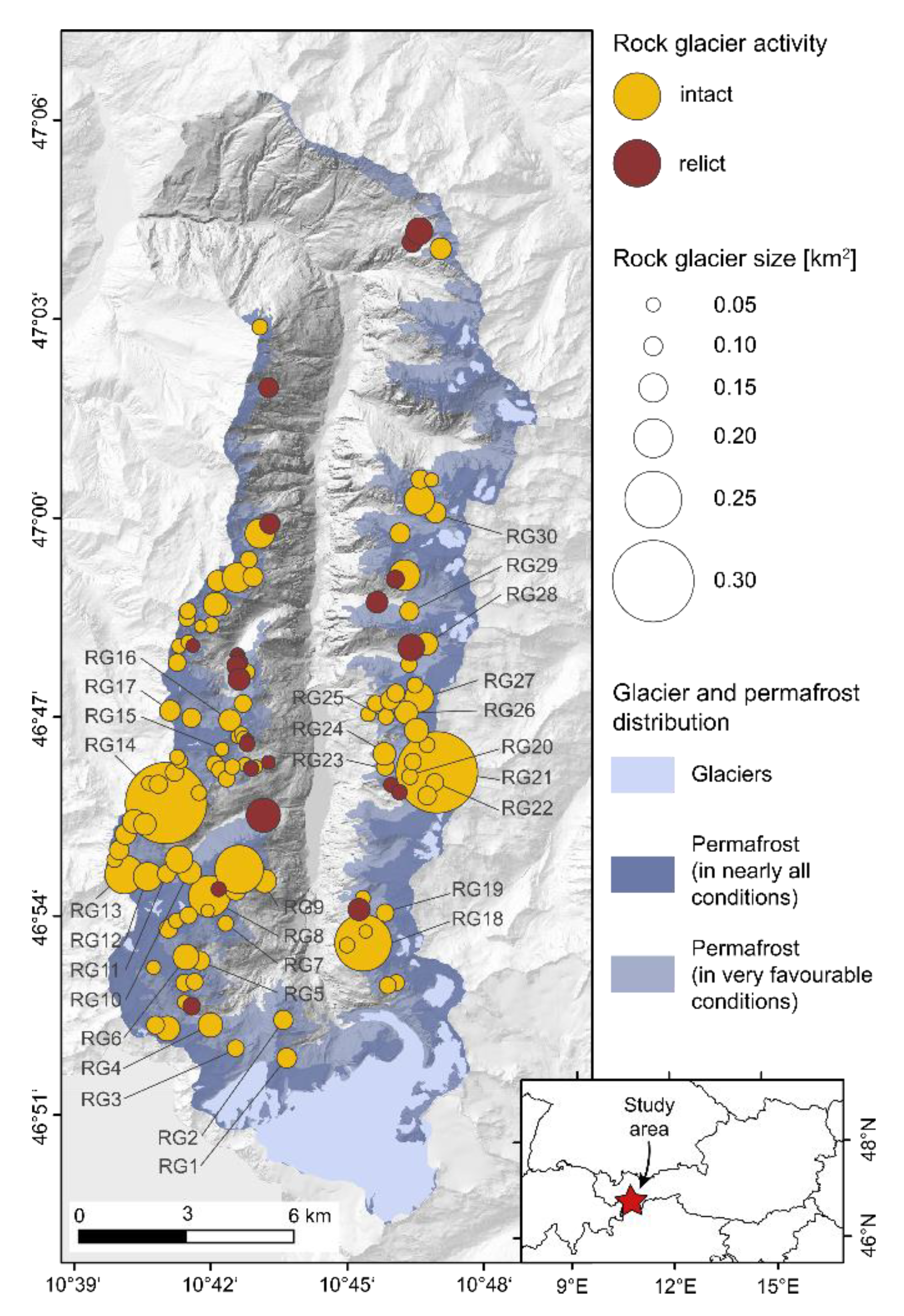
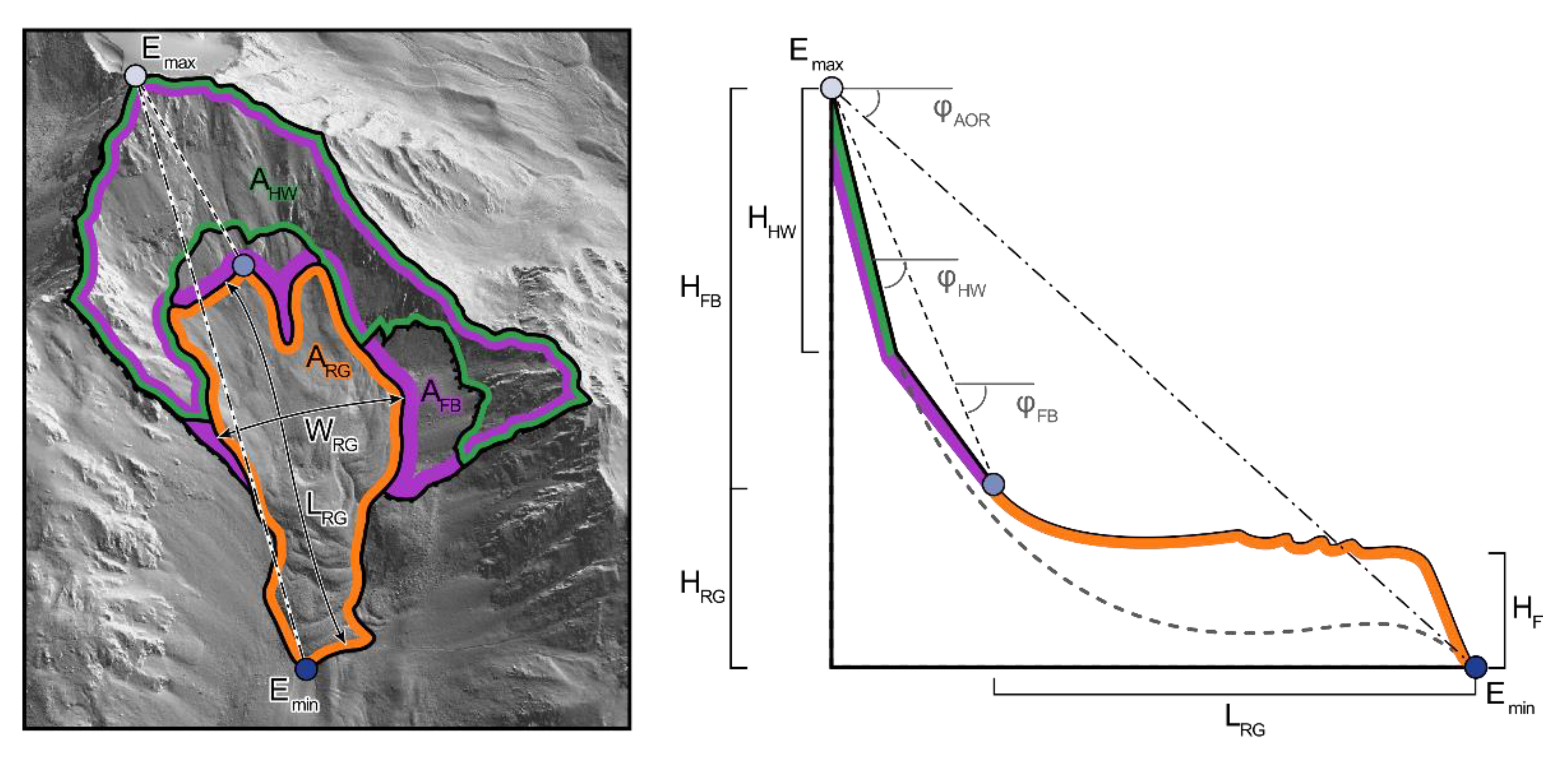
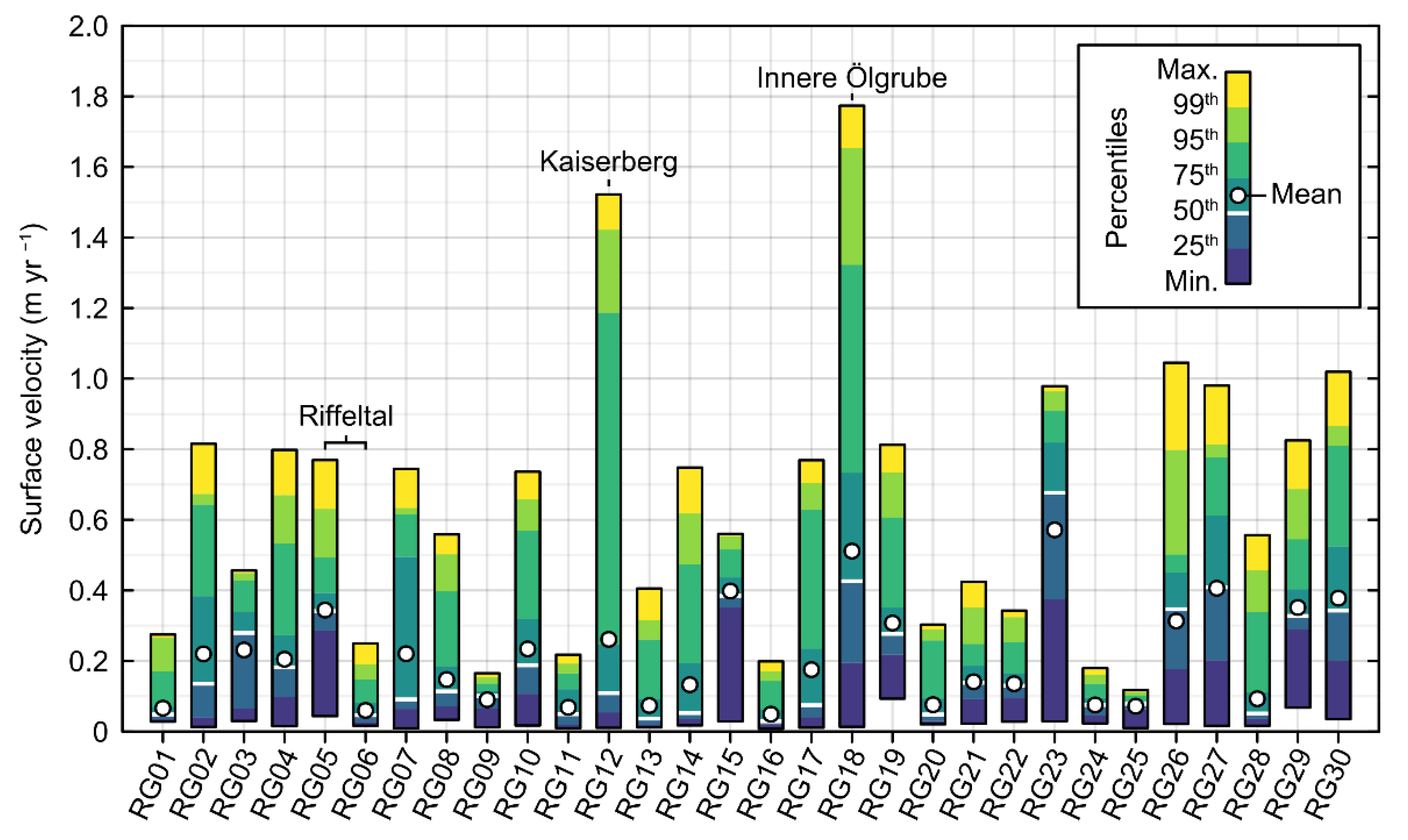
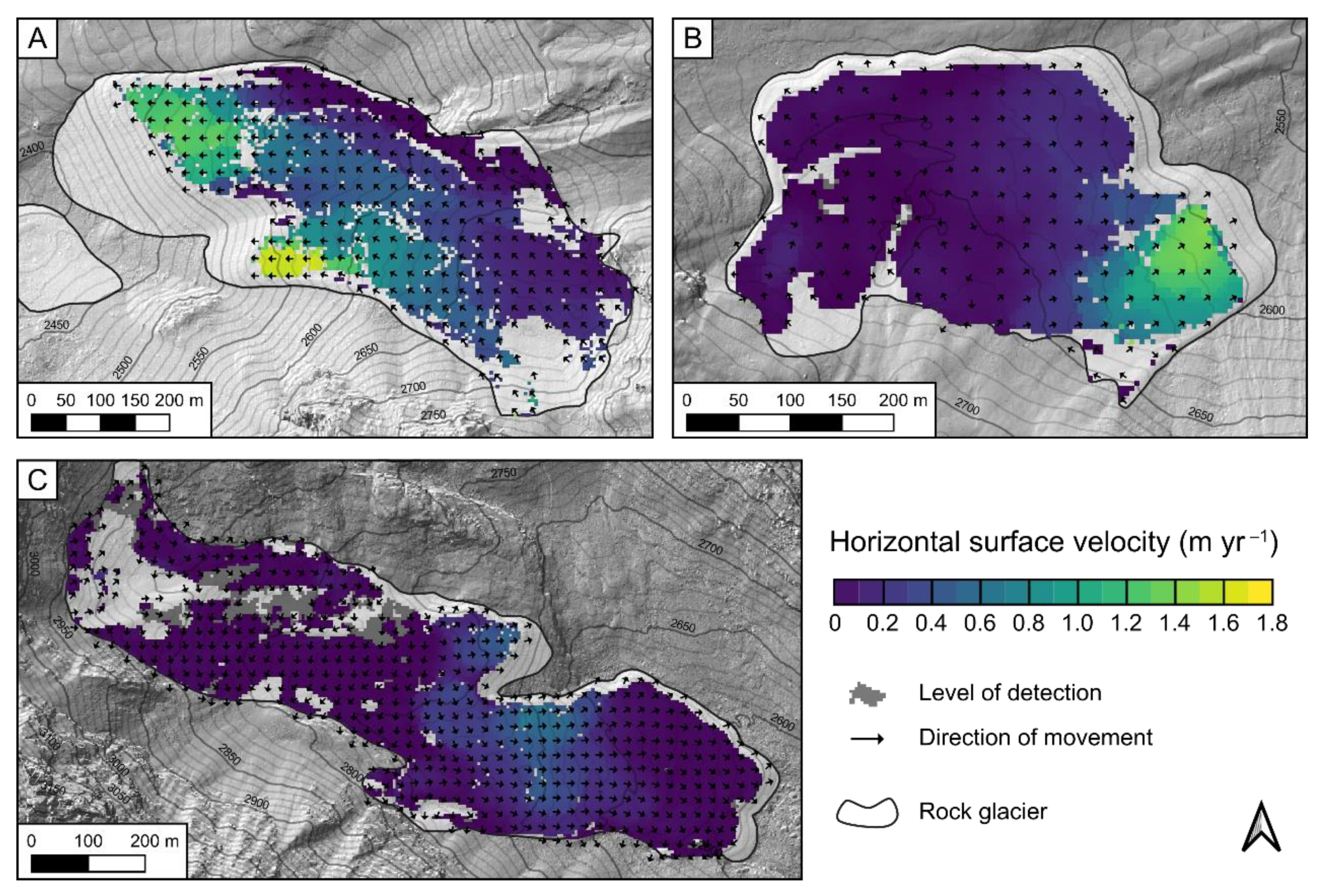
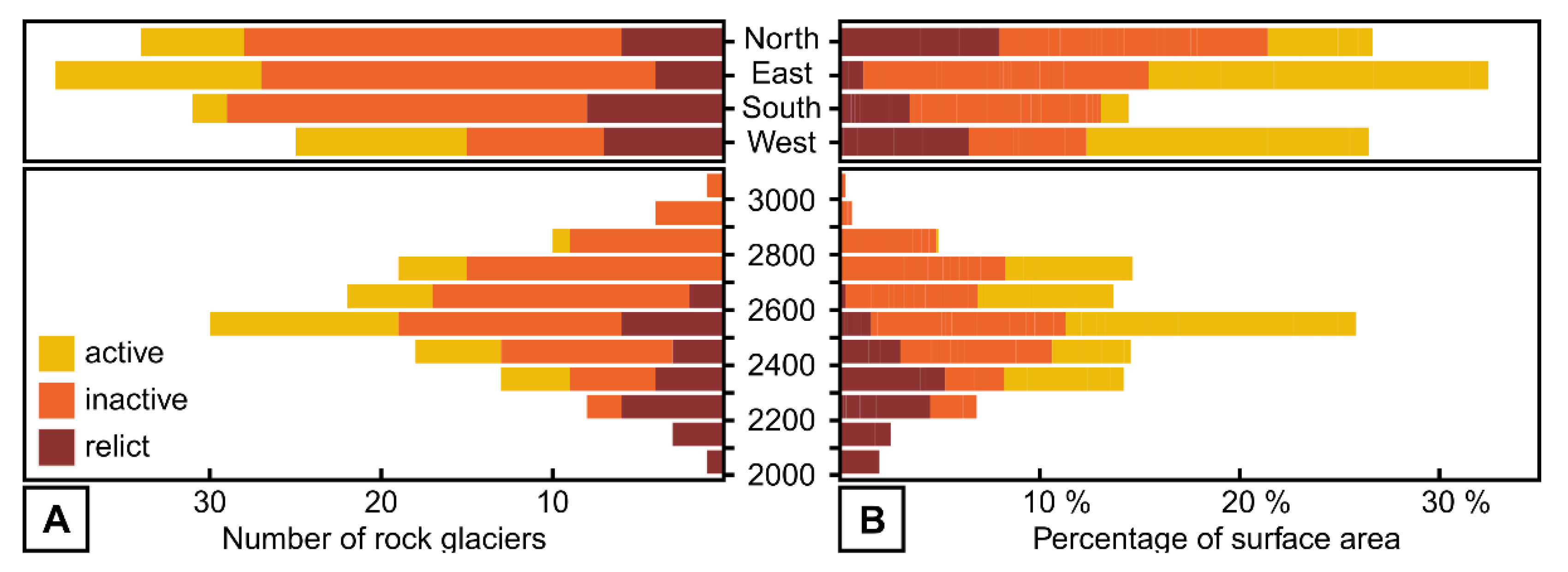
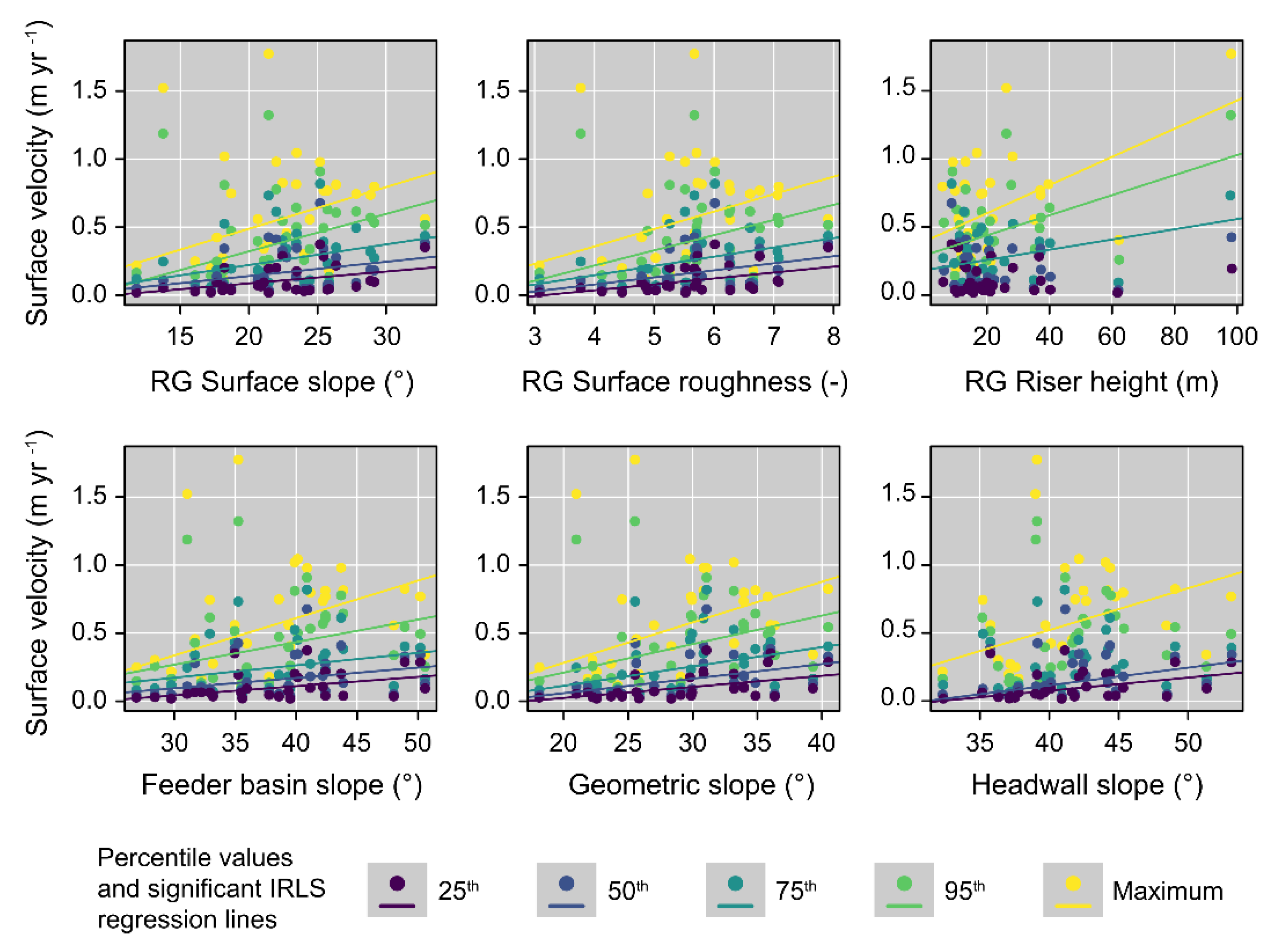

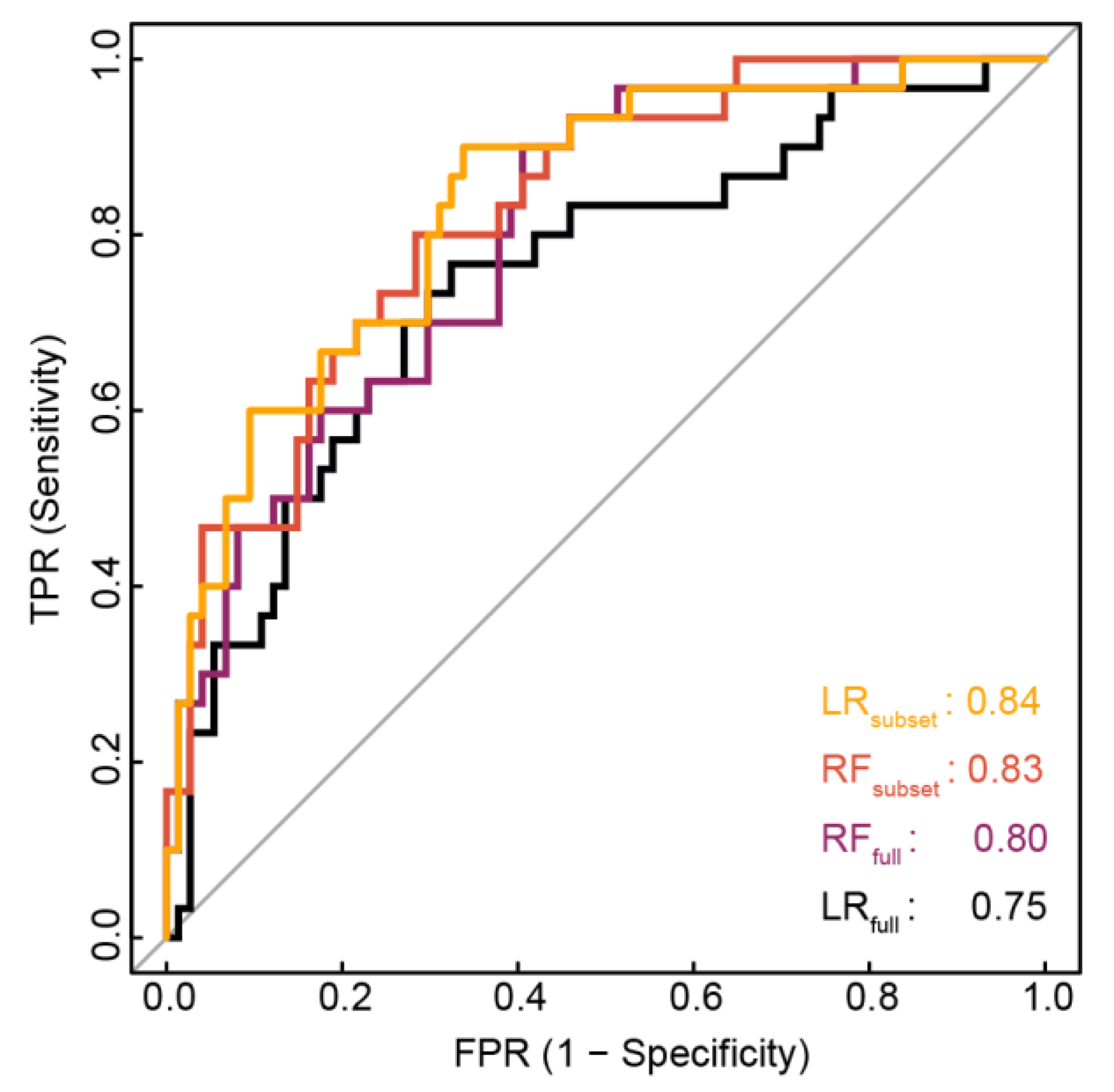
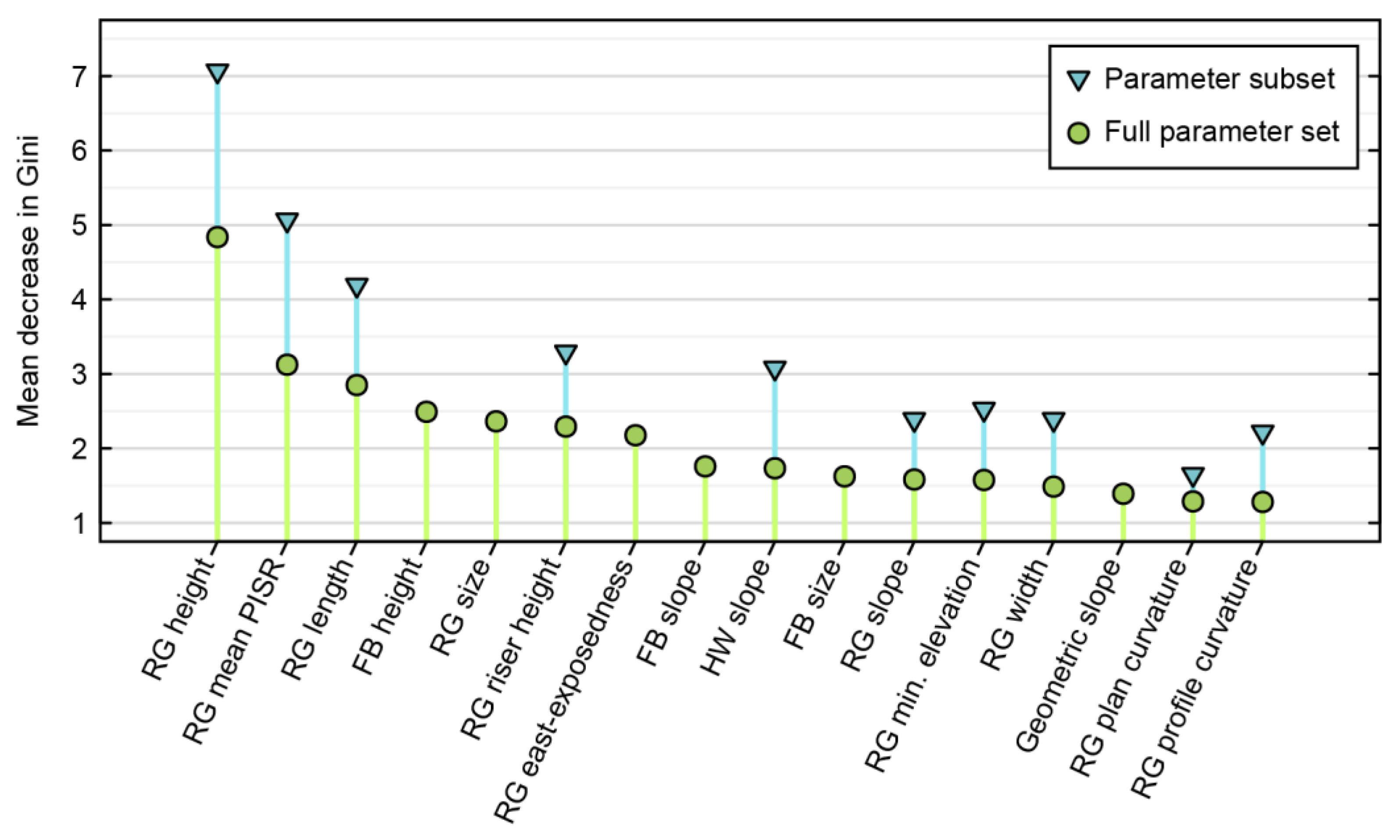
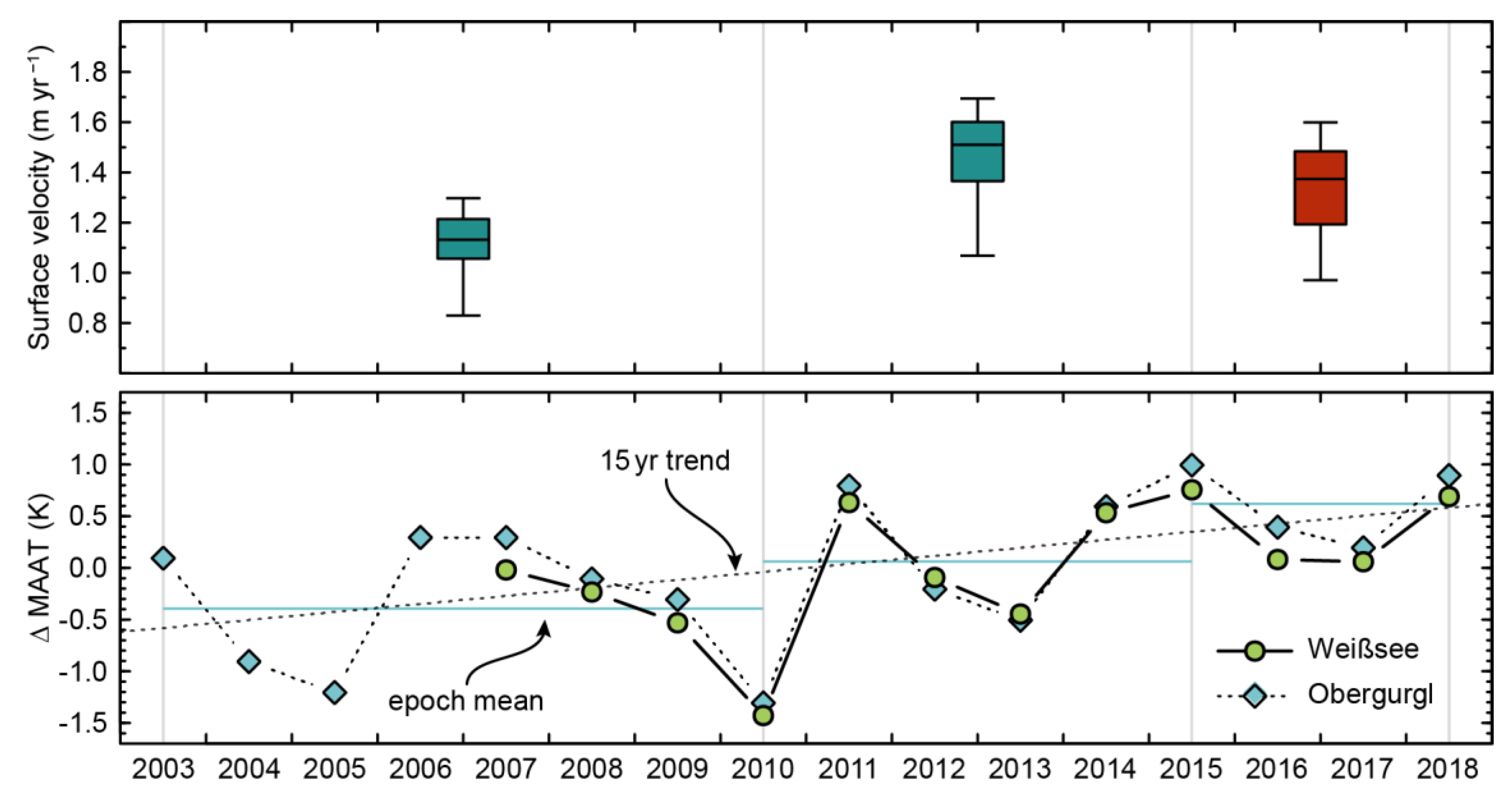
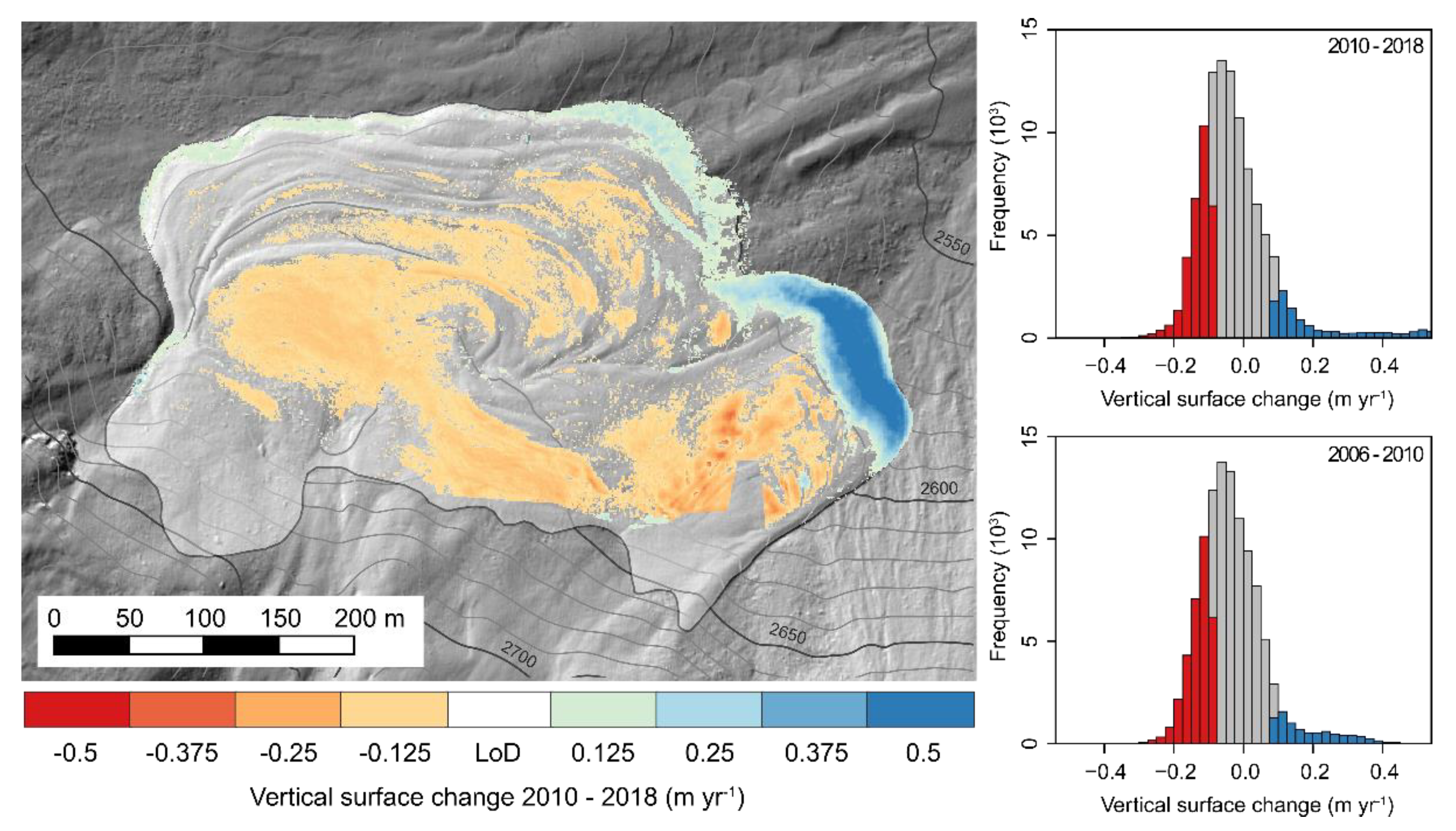
| Period | Acquisition | Ground Resolution | Coverage of Inventory | |
|---|---|---|---|---|
| 2001–2003 | 2001-09-03 2003-07-19 2003-09-05 | 0.2 m * | 39,994 m2 1,795,254 m2 5,884,029 m2 | 0.5% 23.3% 76.2% |
| 2005–2009 | 2005-09-06 2007-09-24 2009-09-08 2009-09-09 | 0.2 m * | 39,994 m2 1,996,841 m2 1,338,780 m2 4,343,662 m2 | 0.5% 25.9% 17.3% 56.3% |
| 2010 | 2010-07-31 2010-09-20 | 0.2 m * | 5,135,343 m2 2,583,934 m2 | 66.5% 33.5% |
| 2015 | 2015-08-03 2015-08-26 2015-08-27 2015-08-28 | 0.2 m * | 2,495,913 m2 1,622,088 m2 3,547,282 m2 53,994 m2 | 32.3% 21.0% 46.0% 0.7% |
| 2018 | 2018-09-28 | 0.05 m † | 126,002 m2 | 1.6% |
| Velocity Percentiles | |||||
|---|---|---|---|---|---|
| Parameters | 25th | 50th | 75th | 95th | Maximum |
| RG east exposedness | 0.38 (−)** | 0.18 (−) | |||
| RG slope | 0.19 (₊) | 0.16 (₊) | 0.21 (₊) | 0.43 (₊) | 0.26 (₊)* |
| RG riser height | 0.14 (₊) | 0.21 (₊) | 0.25 (₊)* | ||
| RG height | 0.19 (₊) | ||||
| RG roughness | 0.22 (₊)* | 0.19 (₊) | 0.19 (₊) | 0.30 (₊)* | 0.20 (₊) |
| FB area | 0.16 (₊) | ||||
| FB height | 0.14 (₊) | ||||
| FB slope | 0.25 (₊)* | 0.16 (₊) | 0.14 (₊) | 0.24 (₊)* | 0.28 (₊)** |
| Geometric slope | 0.31 (₊)* | 0.27 (₊)* | 0.32 (₊)* | 0.30 (₊)* | 0.35 (₊)** |
| HW area | 0.15 (₊) | ||||
| HW slope | 0.35 (₊)** | 0.40 (₊)** | 0.28 (₊)* | ||
© 2019 by the authors. Licensee MDPI, Basel, Switzerland. This article is an open access article distributed under the terms and conditions of the Creative Commons Attribution (CC BY) license (http://creativecommons.org/licenses/by/4.0/).
Share and Cite
Groh, T.; Blöthe, J.H. Rock Glacier Kinematics in the Kaunertal, Ötztal Alps, Austria. Geosciences 2019, 9, 373. https://doi.org/10.3390/geosciences9090373
Groh T, Blöthe JH. Rock Glacier Kinematics in the Kaunertal, Ötztal Alps, Austria. Geosciences. 2019; 9(9):373. https://doi.org/10.3390/geosciences9090373
Chicago/Turabian StyleGroh, Till, and Jan Henrik Blöthe. 2019. "Rock Glacier Kinematics in the Kaunertal, Ötztal Alps, Austria" Geosciences 9, no. 9: 373. https://doi.org/10.3390/geosciences9090373




